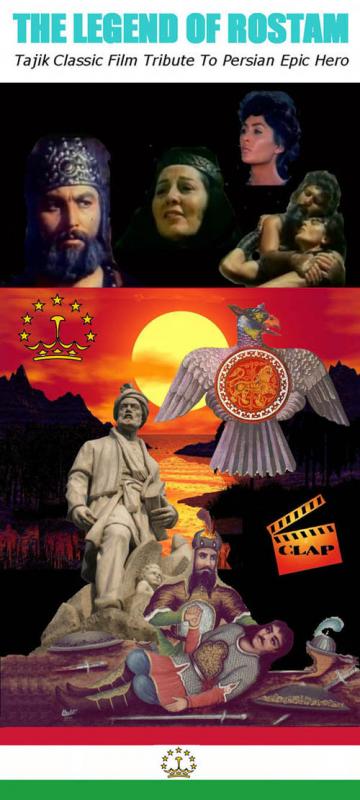
A Pivotal episode of the Legendary Epic Persian Poem of Ferdowsi’s Shahnameh (Book of Kings) put to screen by Tajik director Boris Kimyagarov in 1971.
Learn More about the film here:
by Darius KADIVAR
************************************************
************************************************
TAJIK OPERA IN DOUSHANBEH:
ATASH ZARTOSHT
************************************************
************************************************
************************************************
************************************************
GOOGOOSH SING’s ZARTOSHT
************************************************
************************************************
************************************************
************************************************
THE TIMELESS LEGEND OF ROSTAM & SOHRAB
************************************************
************************************************
Part I:
Part II:
Part III:
Part IV:
Part V:
Part VI:
Part VII:
Part VIII:
Part IX:
Part X:
Plot:
This is the story of “Rustam and Sohrab” from the great Shahnameh (Book ofthe Kings). The Shahnameh is a poetic epic written by the Persian/Tajik poetFerdowsi around 1000 AD. The Shahnameh tells the mythical and historical pastof Persia from the creation of the world up until the Arab invasion of Persia.The Shahnameh, written in Persian, has been pivotal for reviving the Persianlanguage subsequent to the influence of Arabic. The Book of the Kings isregarded as a literary masterpiece which reflects Persia’s history, culturalvalues, its ancient religion, Zoroasterianism, and its profound sense ofnationhood. This particular story of Rustam and Sohrab is only one of the manychapters in the Shahnama. Rustam has always been a hero to Persians/Tajiks aswell as other Persian speakers. The Shahnameh is very important, especiallynowadays, because contrary to what people think today, it does not representjust the political country of Iran. Instead, the epic covers parts ofmodern-day Afghanistan, as well as Iran, Tajikistan, and the cities ofSamarqand and Bukhara. Though the peoples of these regions are separatedagainst their will by such political borders it can not change the fact thatthey share the same language, culture and history and, importantly, Rustam isstill their hero. The Shahnameh is valued above the Quran and fortunately thePersians/Tajiks are rediscovering their roots and shaking loose from the holdthat Arabic had on them. They are realizing just how barbaric the Arabs are andthey are moving away from the Arab culture and Islam and going towards theirown culture and beliefs. Though there are still Persians/Tajiks who defend thesavage acts of the Arabs i.e. forcing their language on the Persians/Tajiks,changing their livelihood, abolishing their legends, etc. These Persians/Tajiksdo not realize the errors of their ways and the fact that they are just pawnsbeing used by the Arabs. As the saying goes, “When there is no enemywithin, the enemies outside cannot hurt you.” Others work to keep thePersians/Tajiks separated for their own advantage. It is legends like Rustamwho serve as reminders of the greatness the Persians/Tajiks come from. And itis books like the Shahnameh that captures the timeless power of a greatculture.
Recommended Book:
The Shahnameh:The Persian Book of Kings of Ferdowsi translated by Dick Davis and an intro by Azar Nafisi
Related Blogs:
BEYOND WORDS: Group Reading of Ferdowsi’s Shahnameh
Related ROYALTY ON SCREEN Blogs:
ROYALTY ON SCREEN : Akira Kurusawa’s 1980 Palme D’Or Film “Kagemusha”
ROYALTY ON SCREEN: Keira Knightley Pioneer Feminist in “The Duchess”
ROYALTY ON SCREEN: James Purefoy and Paul Giamatti in “Ironclad”
ROYALTY ON SCREEN: Kenneth Branagh And An All Star Cast in “Hamlet” (1996)
ROYALTY ON SCREEN: Timothy Dalton and Valeria Golino in “The King’s Whore” (1990)
ROYALTY ON SCREEN: Yul Brynner and Deborah Kerr in “The King and I”
ROYALTY ON SCREEN: Omar Sharif in The tragedy of Mayerling
ROYALTY ON SCREEN: Johansson, Portman and Bana in “The Other Boleyn Girl”
ROYALTY ON SCREEN: Bernardo Bertolucci’s “The Last Emperor” (1987)
ROYALTY ON SCREEN: Jack Black and Emily Blunt in “Gulliver’s Travels”
ROYALTY ON SCREEN: Jonathan Rhys Meyers is King Henry VIII in The “Tudors”
ROYALTY ON SCREEN: Mylène Farmer’s “Libertine 1 & 2” (1986/89)
ROYALTY ON SCREEN: Franklin J. Schaffner’s “Nicholas and Alexandra” (1971)
ROYALTY ON SCREEN: Ian McKellen is “Richard III” in a fascist-inspired version of Britain (1995)
ROYALTY ONSCREEN: Peter O’Toole in “The Lion in Winter” (1968)
ROYALTY ON SCREEN: The Chronicles of Narnia: The Voyage of the Dawn Treader (3D)
ROYALTY ONSCREEN: The Madness of King George (1994)
ROYALTY ONSCREEN: Robert Downey Jr. in “RESTORATION” (1995)
ROYALTY ONSCREEN: Madonna’s Bio Epic Romance on Edward VIII & Wallis Simpson (Due 2011)
ROYALTY ONSCREEN: Colin Firth in “The King’s Speech” (2010)
THE KING’s SPEECH: Press Conference with Cast and Crew at BFI 2010
ROYALTY ON SCREEN: Disney’s take on Grimm Bros’ Rapunzel Tale “Tangled” (3D)
ROYALTY ON SCREEN: McBride, Franco, Portman in “Your Highness”
ROYALTY ON SCREEN: Helen Mirren is Queen Elizabeth II in Stephen Frears’ “The Queen” (2006)






